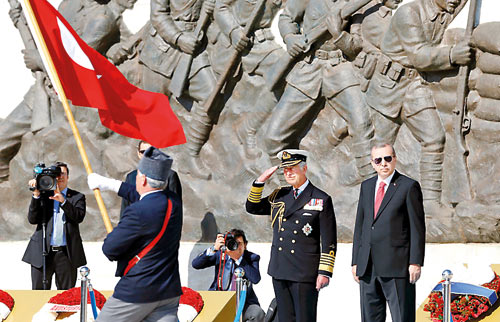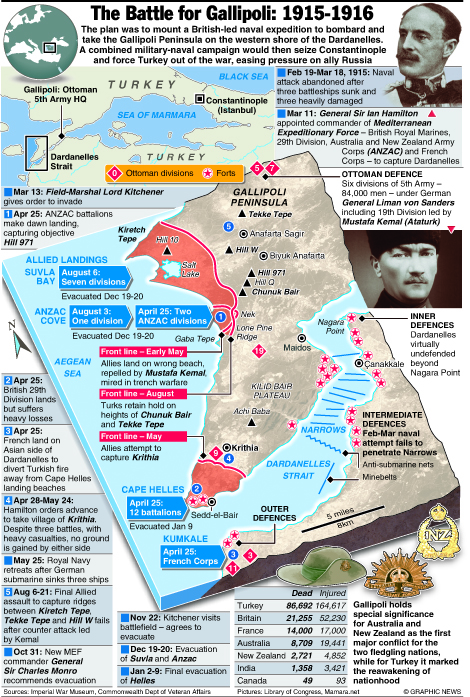Sunday Times 2
Remembering Gallipoli battle: Bravery and bloody slaughter
View(s):Prince Charles and Prince Harry joined heads of state and dignitaries from more than 70 countries in Turkey on Friday and Saturday for a series of commemorations marking the 100th anniversary of arguably the most ill-conceived, poorly led and, ultimately, senseless campaign of the first world war.

Britain's Prince Charles salutes next to Turkey's President Tayyip Erdogan (R) as they attend a ceremony to mark the 100th anniversary of the Battle of Gallipoli in front of the Canakkale Matyrs' Memorial in Gallipoli on Friday. Reuters
In nine months of bloody slaughter, about 58,000 allied soldiers – including 29,000 British and Irish soldiers and 11,000 Australians and New Zealanders – lost their lives during the ill-starred operation to take the Gallipoli peninsula; a further 87,000 Ottoman Turkish troops died fiercely defending their homeland, and at least 300,000 more on both sides were seriously wounded.
Half a dozen commemorative events in Istanbul and on the peninsula – including a ceremony at the Helles memorial, which bears the names of 21,000 British and Commonwealth servicemen who fell at Gallipoli and have no known grave, and the traditional dawn service at the Anzac commemorative site -recalled the chaos, carnage and heroism of a conflict that, while it left the course of the Great War largely untouched, did much to forge the identity of Australia and New Zealand as young, independent nations, and sowed the seeds for the foundation of modern Turkey.
The prime ministers of Australia and New Zealand, Tony Abbott and John Key, along with the Irish president, Michael Higgins, attended several of the ceremonies, held amid tight security with more than 4,000 Turkish police and soldiers on duty.
Gallipoli “was, in a sense, the crucible in which our national identity was forged”, Abbott said in the run-up to the centenary, “but it left horrific scars. It was, in a critical sense, our nation’s baptism of fire – and 8,000 Australians didn’t come back.”
Turkey’s president, Recep Tayyip Erdo?an, sought to underline the theme of reconciliation: “The sons of nations who fought each other on opposing sides 100 years ago will gather under the same roof to convey the message of peace and brotherhood to the world,” he said.
 His remarks, however, were overshadowed by accusations by Armenia that Ankara deliberately brought the Gallipoli centenary commemorations forward to deflect attention from the 100th anniversary – also on 24 April – of the Ottoman massacre of between 1 million and 1.5 million Armenians, which Turkey has always refused to acknowledge as genocide.
His remarks, however, were overshadowed by accusations by Armenia that Ankara deliberately brought the Gallipoli centenary commemorations forward to deflect attention from the 100th anniversary – also on 24 April – of the Ottoman massacre of between 1 million and 1.5 million Armenians, which Turkey has always refused to acknowledge as genocide.
The Gallipoli campaign, badly planned and appallingly executed, was conceived by Winston Churchill, the ambitious First Lord of the Admiralty, in early 1915, with the war on the western front in deadlock. “Are there not other alternatives,” the man destined to be Britain’s second world war saviour inquired, “than sending our armies to chew barbed wire in Flanders?”
The plan was to open up the Dardanelles straits, heavily mined and ably defended on its western shore by Turkish coastal forts and gun batteries on the 50-mile-long Gallipoli peninsula, to allied ships, capture Constantinople – present-day Istanbul – and so link up with Russia, knocking Germany’s ally, Ottoman Turkey, out of the conflict.
Naval operations began in mid-February with heavy and repeated British and French bombardments of the Turkish positions, but were largely unsuccessful; a final attempt to force a passage up the straits on 18 March ended in six allied battleships being sunk or badly damaged.
Military command in London decided in its wisdom that the barren, hilly peninsula would have to be secured by land, and General Sir Ian Hamilton opted for two landings – one by British troops at Cape Helles, at the base of the peninsula, and the other on the western Aegean coast, in the area later known as Anzac Cove, by the Australian and New Zealand Army Corps.
From the start, it was a calamity. Well before the first allied soldiers waded ashore at dawn on 25 April, the Turkish defences had been heavily fortified, and their troops – courageous, disciplined and well dug in, high up on the peninsula’s precipitous inland ridges – reinforced six times over.
The invading troops came under deadly fire from the moment they hit the beach. Despite many showing immense bravery – famously, half a dozen Victoria Crosses were won “before breakfast” on the first day of the Gallipoli landings by officers and men from the First Battalion, Royal Lancashire Fusiliers, who lost all but 21 of their first 200 men ashore – the allies were unable to make good their advance.
On 27 April, after two days of remorseless fighting, a young Australian private, Archibald Barwick, wrote: “I had two rifles smashed in my hands … The piece of ground opposite us was literally covered with dead bodies, our own boys and Turks. God knows what our losses were, must have run into thousands.”
In fact, few allied troops ever made it much further than a few hundred metres from the shore, and the battle soon descended into trench warfare, in truly atrocious conditions. Thousands struggled, and often succumbed, in suffocating heat, with rotting corpses that drew thick swarms of flies, a chronic lack of water, typhoid, the all-but-ubiquitous dysentery and, finally, a winter cold enough to freeze 280 men to death.
With losses on both sides mounting steeply, a fresh British landing at Suvla Bay, a few miles from Anzac Cove, was launched in August 1915 to support a bitter attempt to break out and push at least a little way further inland by the enclosed Australian and New Zealand troops.
Wading ashore that month, a British private, Leonard Thompson, ran up the beach to a large marquee. Pulling back the canvas flaps, he recorded in his diary, he saw: “It was full of corpses. Dead Englishmen, lots and lots of them, with their eyes wide open.”
But despite ferocious, sometimes hand-to-hand fighting, more terrible losses – at Chunuk Bair, one New Zealand unit lost 90% of its men – and remarkable courage, with Australian troops at a ridge known as Lone Pine winning seven VCs in the space of three days, this last-ditch summer offensive would prove as ineffectual as the original landings.
Bowing to the inevitable, the war council in London finally decided to withdraw the Anzac forces in late December, with the last British troops leaving the peninsula on 8 January; ironically, the evacuation was by far the most successful part of the operation, ending with the loss of only a handful of lives.
A military debacle of epic proportions and a byword for poor planning and arrogant, incompetent top brass that would blight Churchill’s career for years, Gallipoli has become a cornerstone of Australian and New Zealand national pride, the birthplace of the core Antipodean values of pluck, endurance, heroism, sacrifice, dark humour and – above all – “mateship”.
For Turkey, the victory saw the triumph of Mustafa Kemal, a 33-year-old lieutenant colonel who commanded the 19th Turkish Division and famously told his men: “I don’t order you to attack; I order you to die.” As Mustafa Kemal Atatürk, he became the founding father of the Turkish republic in 1923.
Courtesy the Guardian, UK

